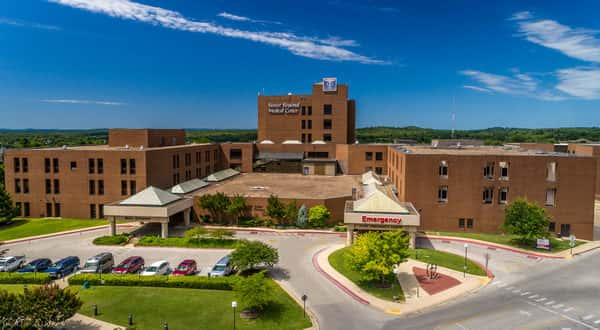
Baxter Regional Medical Center has not yet had a confirmed case of COVID-19, but the Mountain Home hospital is nevertheless feeling the impacts of the pandemic.While hospitals in hot spots like New York have been filled to near capacity with COVID patients, many hospitals elsewhere have experienced the reverse. The delay of nonemergency procedures and other declines in hospital visits as people stay at home have dramatically slowed the volume of patients at Baxter Regional, leaving the hospital perilously short on revenues.Ron Peterson, Baxter Regional’s CEO, says “We are literally fighting for our survival at this point.” The hospital recently announced a series of cuts to salaries and staffing, followed by a second of furloughs on April 17 that brought the total reduction in staff positions to 350.is an example of what’s happening at almost every hospital across the state of Arkansas,” says Bo Ryall, president of the Arkansas Hospital Association. Hundreds of employees across the state have been furloughed as hospitals are forced to impose cuts in the wake of revenue shortfalls related to COVID-19. Some hospitals are seeing revenues down 50 to 75 percent, Ryall says.The financial picture remains dire at Baxter Regional, Peterson says, despite significant aid from various initiatives enacted by the state and federal government to try to help hospitals survive the crisis. The CARES Act, the federal stimulus bill passed by Congress this month, included $100 billion for medical providers, including hospitals, of which $30 billion has been doled out to states. Arkansas has thus far distributed $326 million to 2,905 providers in the state, including Baxter Regional, which received $6 million.
Last month, the governor announced a $116 million Medicaid-funded initiative to help providers and hospitals, as well as a $10 million community development block grant program to help rural hospitals. Peterson says it was too early to say what impact the $116 million initiative would have on Baxter. On April 18, the governor announced the distribution of the $10 million in grants to 27 hospitals in the state, including $500,000 to Baxter Regional.
All of these measures, as well as other state and federal initiatives to aid hospitals during the pandemic, have been helpful, Ryall said. “But it certainly doesn’t backfill all the revenue that has been lost,” he said. “Every little bit helps and we’re appreciative of everything, but we’ve got big numbers that are occurring right now.”
Baxter Regional began experiencing a decrease in the volume of patients it sees around the middle of March.
“Patients are taking our advice and doing the right thing, staying home,” Peterson says.
Elective procedures and routine appointments were already being postponed when the state mandated on April 3 that procedures, testing and office visits that could be safely postponed had to be rescheduled. The hospital is also seeing fewer trauma patients as people spend more time at home (for example, people are less likely to wind up in an automobile accident). Others may be resisting coming to the hospital for needed care because of fears of the virus. All told, volume throughout Baxter Regional, including emergency services, physician offices and inpatient stays, has fallen by around 30%, translating to a decline in revenues of roughly 40%.
The fall in revenues comes alongside increases in costs to prepare for COVID-19. Patients suspected of COVID-19 have to be treated as if they are infected until the hospital gets confirmation of a negative test, which has increased the hospital’s utilization of personal protective equipment (PPE), such as N95 masks. Masks used to cost around 95 cents each. The price has now spiked to around $3 each (some sellers are asking for $5 or more, Peterson says, which would push costs up even further if the hospital ever faced a shortage and had to seek additional sellers). Testing remains a challenge, as the hospital is still unable to test on-site. Initially, tests sent to the Arkansas Department of Health in early March had a 6-to-8 day turnaround, but that has more recently improved to 24 to 48 hours, Peterson said.
Like many of the state’s rural hospitals, Baxter Regional’s fiscal situation was already tight before the crisis.
“For the last several years, we’ve had a 2% operating margin,” Peterson said. “That’s the average, if you’re lucky. There’s several rural hospitals that I don’t even believe have that kind of operating margin. But that’s a very slim margin and when you start dropping 30 to 35% of your volume, you have to take a look at how can you keep the organization sustained and survive.”
The hospital normally operates in the black on a monthly basis, but for the month of March, the hospital was $1.4 million in the red; the projection for April is a shortfall of $6 to $6.5 million. May could likely be even worse, Peterson says.
On April 6, the hospital announced a series of cuts to deal with the temporary shortfalls related to COVID-19: a hold on annual market-based pay increases, reductions in salary for executives and the leadership team, reduction in hours for many workers, a hiring freeze for noncritical positions and furloughing 105 employees. Those furloughed will continue to receive health insurance from Baxter Regional and will be eligible for unemployment compensation.
Baxter Regional’s second round of 175 furloughs brought the total to 280. The number of positions that have been left vacant under the hiring freeze is up to 70. The hope is that all of these moves will be temporary. The hospital stated in a press release: “Baxter Regional realizes that these are difficult days for our nation, state, local community and organization but is confident we will get through this together and overcome these challenges.”
When the health care industry takes a hit, it has a profound impact on the local economy, Peterson said. Prior to the cuts, Baxter Regional employed around 1,700 people, making it by far the largest employer in the community. One in four jobs in Baxter County are health-care related, including the hospital and independent providers.
Peterson says that he anticipates volume will pick up in the near future.
“The drop can only go on for so long,” he says. “Health care services can be delayed, but I believe there will be pent-up demand and there’s going to be a burst at some point.”
In this way, rural hospitals face a dilemma not dissimilar to small businesses like restaurants — demand for services that doesn’t exist now will be coming soon, but without significant cash reserves or huge margins from previous years, the immediate revenue hit makes it hard to stay afloat.
“You have to look at how you survive and be prepared for the surge and the influx weeks later,” Peterson adds.
In the meantime, hospitals like Baxter Regional also must prepare for the possibility of a COVID-19 outbreak. As of April 20, there have been just five confirmed cases in Baxter County and one in Marion County, the hospital’s primary service areas.
“Thank goodness, and hopefully a surge does not happen, but you do have to plan for that,” Peterson says.
The hospital has a team dedicated to COVID response which has been meeting daily since the first confirmed case in Arkansas on March 11. In the case of a surge of COVID-19 cases, the hospital has 49 beds that could be used to treat COVID patients, in rooms that could be converted to have negative air pressure to contain the virus, including nine in the ICU.
The hospital has 17 ventilators and 17 anesthesia machines. Additional beds could potentially be converted if a surge stretched that capacity, including an additional eight ICU beds– in which case small, critical-access hospitals in the region could help by taking on non-COVID patients.
In addition to the federal stimulus payments from the CARES Act and the block grant aid from the state, Arkansas has also initiated a $75 million program, paid for with the governor’s rainy day fund, to provide PPE to health care providers. Baxter Regional received its first shipment last week, including around 2,400 gowns and 26,000 gloves, with more expected soon.
The state and federal government have also established plans to advance money now to help with immediate cashflow that hospitals and other providers will eventually repay. Arkansas has delayed Medicaid-related payments that hospitals would normally owe the state now until June, and the federal government has fronted Medicare reimbursement payments now that providers can pay back later this year.
“We appreciate everything that’s being done, and it’s all been beneficial,” Peterson says. “But hospitals in rural areas that are large enough to be able to handle COVID patients and are operating on very thin margins — it’s a very difficult time for us at this moment.”
If the revenues don’t turn around soon, he said, it could threaten the ability of Baxter Regional and similar hospitals to sustain themselves in their current form.
“It could change the landscape of hospitals in rural Arkansas, there’s no question,” says Peterson.
“It’s a bleak picture right now,” Ryall says. “I’m hearing from hospitals that got their March numbers, and looking toward April and May it’s going to be devastating. That’s why you’re seeing the furloughs and cuts. Hospitals are just trying to survive to when the patients do come back.”
The Arkansas Hospital Association has provided grant money to ANNN.
This reporting is courtesy of the Arkansas Nonprofit News Network, an independent, nonpartisan news project dedicated to producing journalism that matters to Arkansans.
WebReadyTM Powered by WireReady® NSI










